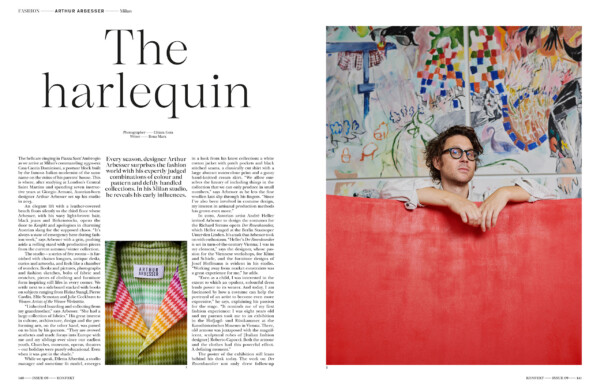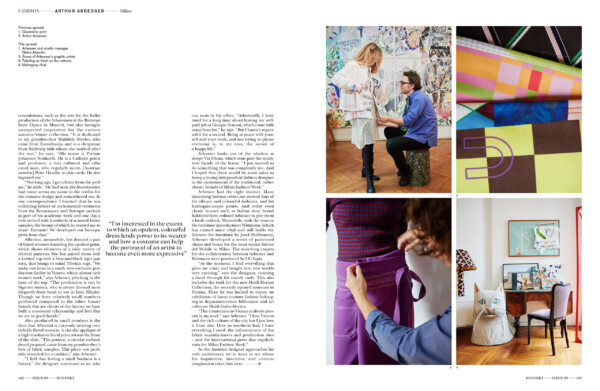Ilona Marx
Editorial work / Concepts / Texts
The harlequin
Fashion / Interview
Every season, designer Arthur Arbesser surprises the fashion world with his expertly judged combinations of colour and pattern and deftly handled collections. In his Milan studio, he reveals his early influences.
The bells are ringing in Piazza Sant’Ambrogio as we arrive at Milan’s commanding 1950s-era Casa Caccia Dominioni, a postwar block built by the famous Italian modernist of the same name on the ruins of his parents’ house. This is where, after studying at London’s Central Saint Martins and spending seven instructive years at Giorgio Armani, Austrian-born designer Arthur Arbesser set up his studio in 2013.
An elegant lift with a leather-covered bench floats silently to the third floor where Arbesser, with his wavy light-brown hair, black jeans and Birkenstocks, opens the door to Konfekt and apologises in charming Austrian slang for the supposed chaos. “It’s always a state of emergency here during fashion week,” says Arbesser with a grin, pushing aside a rolling stand with production pieces from the current autumn/winter collection.
The studio – a series of five rooms – is furnished with chaises longues, antique desks, curios and artworks, and feels like a chamber of wonders. Books and pictures, photographs and fashion sketches, bolts of fabric and swatches, pieces of clothing and furniture form inspiring still lifes in every corner. We settle next to a sideboard stacked with books on subjects ranging from Heinz Stangl, Pierre Cardin, Elfie Semotan and Julie Cockburn to Women Artists of the Wiener Werkstätte.
“I inherited hoarding and collecting from my grandmother,” says Arbesser. “She had a large collection of fabrics.” His great interest in culture, architecture, design and the performing arts, on the other hand, was passed on to him by his parents. “They are avowed aesthetes and made forays into Europe with me and my siblings ever since our earliest youth. Churches, museums, operas, theatres – our holidays were purely educational. Even when it was 40C in the shade.”
While we speak, Diletta Albertini, a studio manager and sometime fit model, emerges in a look from his latest collection: a white cotton jacket with patch pockets and black stitched seams, a classically cut shirt with a large abstract watercolour print and a gauzy hand-knitted cream skirt. “We allow ourselves the luxury of including things in the collection that we can only produce in small numbers,” says Arbesser as he lets the fine woollen knit slip through his fingers. “Since I’ve also been involved in costume design, my interest in artisanal production methods has grown even more.”
In 2020, Austrian artist André Heller invited Arbesser to design the costumes for the Richard Strauss opera Der Rosenkavalier, which Heller staged at the Berlin Staatsoper Unter den Linden. It’s a task that Arbesser took on with enthusiasm. “Heller’s Der Rosenkavalier is set in turn-of-the-century Vienna; I was in my element,” says the designer, whose passion for the Viennese workshops, for Klimt and Schiele, and the furniture designs of Josef Hoffmann is evident in his studio. “Working away from market constraints was a great experience for me,” he adds.
“Even as a child, I was interested in the extent to which an opulent, colourful dress lends power to its wearer. And today, I am fascinated by how a costume can help the portrayal of an artist to become even more expressive,” he says, explaining his passion for the stage. “It reminds me of my first fashion experience: I was eight years old and my parents took me to an exhibition in the Hofjagd- und Rüstkammer at the Kunsthistorisches Museum in Vienna. There, old armour was juxtaposed with the magnificent, sculptural robes of [Italian fashion designer] Roberto Capucci. Both the armour and the clothes had this powerful effect. A defining moment.”
The poster of the exhibition still leans behind his desk today. The work on Der Rosenkavalier not only drew follow-up commissions, such as the sets for the ballet production of Der Schneesturm at the Bavarian State Opera in Munich, but also brought unexpected inspiration for the current autumn/winter collection. “It is dedicated to my grandmother Mathilde Binder, who came from Transylvania, and to a clergyman from Salzburg with whom she worked after the war,” he says. “His name is Prelate Johannes Neuhardt. He is a Catholic priest and professor, a very cultured and educated man, who regularly meets [Austrian novelist] Peter Handke to play cards. He also baptised me.”
“Not long ago, I got a letter from the prelate,” he adds. “He had seen Der Rosenkavalier, had come across my name in the credits for the costume design and remembered me. In our correspondence I learned that he was collecting fabrics of ecclesiastical vestments from the Renaissance and Baroque periods as part of his academic work and one day a DVD arrived with hundreds of scanned fabric samples, the beauty of which he wanted me to share. Fantastic! We developed our baroque print from that.”
Albertini, meanwhile, has donned a pair of flared trousers featuring the opulent print, which shows elements of a wide variety of clerical patterns. She has paired them with a knitted top with a blue-and-black tiger pattern, that brings to mind Tibetan rugs. “We make our knits in a small, very exclusive production facility in Veneto, where almost only women work,” says Arbesser, plucking at the hem of the top. “The production is run by Signora Aurora, who is always dressed most elegantly from head to toe in Issey Miyake. Though we have relatively small numbers produced compared to the other luxury brands that are clients of the factory, we have built a consistent relationship and feel that we are in good hands.”
Also produced in small numbers is the shirt that Albertini is currently wearing over stylishly flared trousers. A circular appliqué of a high-resolution floral print adorns the front of the shirt. “The pattern, a circular embroidered jacquard, came from my grandmother’s box of fabric samples. This piece was probably intended for a cushion,” says Arbesser.
“I feel that having a small business is a luxury,” the designer continues as we take our seats in his office. “Admittedly, I hesitated for a long time about leaving my well-paid job at Giorgio Armani, which came with many benefits,” he says. “But I haven’t regretted it for a second. Being at peace with yourself and your work, and not trying to please everyone is, in my eyes, the secret of a happy life.”
Arbesser looks out of the window at sleepy Via Olona, which runs past the south-west façade of the house. “I just wanted to do something that was completely me. And I hoped that there would be some value to being a young independent fashion designer in the environment of the traditional, rather classic, brands of Milan Fashion Week.”
Arbesser had the right instinct. Many discerning fashion critics are avowed fans of his vibrant and colourful fashions, and his harlequin-esque prints. And today even classic houses such as Italian shoe brand Baldinini have enlisted Arbesser to give them a fresh outlook. Meanwhile, with the venerable furniture manufacturer Wittmann (which has existed since 1896 and still holds the licences for furniture by Josef Hoffmann), Arbesser developed a series of patterned chairs and boxes for the most recent Salone del Mobile in Milan. The matching carpets for the collaboration between Arbesser and Wittmann were produced by CC-Tapis.
“At the moment, I find everything that gives me entry and insight into new worlds very exciting,” says the designer, running a hand through his unruly curls. This also includes the work for the new Heidi Horten Collection, the recently opened museum in Vienna. Here he was invited to curate an exhibition of haute couture fashion belonging to department-store billionaire and art collector Heidi Goëss-Horten.
“The connection to Vienna is always present in my work,” says Arbesser. “I love Vienna and the rich culture of the city but I just love it from afar. Here in northern Italy I have everything I need: the infrastructure of the fabric manufacturers and production sites – and the international press that regularly visits for Milan Fashion Week.”
As the Austrian designer approaches his 10th anniversary, we’re keen to see where his inquisitive, inventive and curious imagination takes him next.
Konfekt,
Winter 22/23

